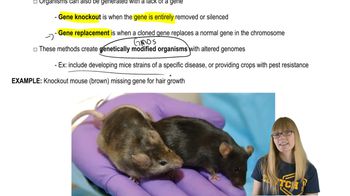There are a variety of circumstances under which rapid results using multiple markers in PCR amplifications are highly desired, such as in forensics, pathogen analysis, or detection of genetically modified organisms. In multiplex PCR, multiple sets of primers are used, often with less success than when applied to PCR as individual sets. Numerous studies have been conducted to optimize procedures, but each has described the process as time consuming and often unsuccessful. Considering the information given in Problem 30, why should multiplex PCR be any different than single primer set PCR in terms of dependability and ease of optimization?
Table of contents
- 1. Introduction to Genetics51m
- 2. Mendel's Laws of Inheritance3h 37m
- 3. Extensions to Mendelian Inheritance2h 41m
- 4. Genetic Mapping and Linkage2h 28m
- 5. Genetics of Bacteria and Viruses1h 21m
- 6. Chromosomal Variation1h 48m
- 7. DNA and Chromosome Structure56m
- 8. DNA Replication1h 10m
- 9. Mitosis and Meiosis1h 34m
- 10. Transcription1h 0m
- 11. Translation58m
- 12. Gene Regulation in Prokaryotes1h 19m
- 13. Gene Regulation in Eukaryotes44m
- 14. Genetic Control of Development44m
- 15. Genomes and Genomics1h 50m
- 16. Transposable Elements47m
- 17. Mutation, Repair, and Recombination1h 6m
- 18. Molecular Genetic Tools19m
- 19. Cancer Genetics29m
- 20. Quantitative Genetics1h 26m
- 21. Population Genetics50m
- 22. Evolutionary Genetics29m
18. Molecular Genetic Tools
Genetic Cloning
Problem 1a
Textbook Question
What experimental evidence confirms that we have introduced a useful gene into a transgenic organism and that it performs as we anticipate?
 Verified step by step guidance
Verified step by step guidance1
Step 1: Begin by identifying the transgenic organism and the gene of interest that has been introduced. This involves understanding the purpose of the gene and the expected phenotype or function it should confer to the organism.
Step 2: Use molecular techniques such as PCR (Polymerase Chain Reaction) or Southern blotting to confirm the presence of the introduced gene in the organism's genome. These methods detect specific DNA sequences and verify successful integration.
Step 3: Assess the expression of the introduced gene by analyzing mRNA levels using techniques like RT-PCR (Reverse Transcription PCR) or Northern blotting. This step ensures that the gene is actively transcribed into RNA.
Step 4: Evaluate protein production by performing Western blotting or ELISA (Enzyme-Linked Immunosorbent Assay) to confirm that the gene is translated into its corresponding protein. This step verifies functional expression at the protein level.
Step 5: Conduct phenotypic or functional assays to determine if the transgenic organism exhibits the anticipated traits or behaviors. For example, if the gene confers resistance to a specific pathogen, test the organism's resistance under controlled conditions.
 Verified video answer for a similar problem:
Verified video answer for a similar problem:This video solution was recommended by our tutors as helpful for the problem above
Video duration:
34sPlay a video:
Was this helpful?
Key Concepts
Here are the essential concepts you must grasp in order to answer the question correctly.
Transgenic Organisms
Transgenic organisms are those that have been genetically modified to contain a gene or genes from another species. This process involves techniques such as gene cloning and transformation, allowing for the introduction of specific traits. Understanding how these organisms are created and the implications of their genetic modifications is crucial for evaluating their functionality and utility.
Recommended video:
Guided course

Transgenic Organisms and Gene Therapy
Gene Expression Analysis
Gene expression analysis involves measuring the activity of a gene to determine if it is being expressed in the transgenic organism. Techniques such as quantitative PCR, Northern blotting, or RNA sequencing can be used to assess the presence and levels of mRNA, indicating whether the introduced gene is functioning as intended. This analysis is essential for confirming the successful integration and activity of the transgene.
Recommended video:
Guided course

Penetrance and Expressivity
Phenotypic Assessment
Phenotypic assessment refers to the evaluation of observable traits or characteristics in an organism. In the context of transgenic organisms, this involves assessing whether the introduced gene produces the expected traits, such as increased resistance to pests or enhanced growth rates. By comparing the phenotypes of transgenic organisms with non-transgenic controls, researchers can determine the effectiveness of the genetic modification.
Recommended video:
Guided course

Mutations and Phenotypes
Related Videos
Related Practice
Textbook Question
353
views


